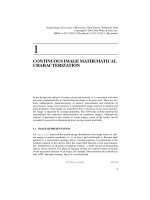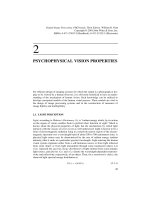Tài liệu Xử lý hình ảnh kỹ thuật số P5 pdf
Bạn đang xem bản rút gọn của tài liệu. Xem và tải ngay bản đầy đủ của tài liệu tại đây (333.88 KB, 19 trang )
121
5
DISCRETE IMAGE MATHEMATICAL
CHARACTERIZATION
Chapter 1 presented a mathematical characterization of continuous image fields.
This chapter develops a vector-space algebra formalism for representing discrete
image fields from a deterministic and statistical viewpoint. Appendix 1 presents a
summary of vector-space algebra concepts.
5.1. VECTOR-SPACE IMAGE REPRESENTATION
In Chapter 1 a generalized continuous image function F(x, y, t) was selected to
represent the luminance, tristimulus value, or some other appropriate measure of a
physical imaging system. Image sampling techniques, discussed in Chapter 4,
indicated means by which a discrete array F(j, k) could be extracted from the contin-
uous image field at some time instant over some rectangular area ,
. It is often helpful to regard this sampled image array as a
element matrix
(5.1-1)
for where the indices of the sampled array are reindexed for consistency
with standard vector-space notation. Figure 5.1-1 illustrates the geometric relation-
ship between the Cartesian coordinate system of a continuous image and its array of
samples. Each image sample is called a pixel.
J– jJ≤≤
K– kK≤≤ N
1
N
2
×
F Fn
1
n
2
,()[]=
1 n
i
N
i
≤≤
Digital Image Processing: PIKS Inside, Third Edition. William K. Pratt
Copyright © 2001 John Wiley & Sons, Inc.
ISBNs: 0-471-37407-5 (Hardback); 0-471-22132-5 (Electronic)
122
DISCRETE IMAGE MATHEMATICAL CHARACTERIZATION
For purposes of analysis, it is often convenient to convert the image matrix to
vector form by column (or row) scanning F, and then stringing the elements together
in a long vector (1). An equivalent scanning operation can be expressed in quantita-
tive form by the use of a operational vector and a matrix
defined as
(5.1-2)
Then the vector representation of the image matrix F is given by the stacking opera-
tion
(5.1-3)
In essence, the vector extracts the nth column from F and the matrix places
this column into the nth segment of the vector f. Thus, f contains the column-
FIGURE 5.1-1. Geometric relationship between a continuous image and its array of
samples.
N
2
1× v
n
N
1
N
2
⋅ N
2
× N
n
v
n
0
0
1
0
0
=
…
…
1
n 1–
n
n 1+
N
2
…
…
N
n
0
0
1
0
0
=
……
1
n 1–
n
n 1+
N
2
……
fN
n
Fv
n
n 1
=
N
2
∑
=
v
n
N
n
GENERALIZED TWO-DIMENSIONAL LINEAR OPERATOR
123
scanned elements of F. The inverse relation of casting the vector f into matrix form
is obtained from
(5.1-4)
With the matrix-to-vector operator of Eq. 5.1-3 and the vector-to-matrix operator of
Eq. 5.1-4, it is now possible easily to convert between vector and matrix representa-
tions of a two-dimensional array. The advantages of dealing with images in vector
form are a more compact notation and the ability to apply results derived previously
for one-dimensional signal processing applications. It should be recognized that Eqs
5.1-3 and 5.1-4 represent more than a lexicographic ordering between an array and a
vector; these equations define mathematical operators that may be manipulated ana-
lytically. Numerous examples of the applications of the stacking operators are given
in subsequent sections.
5.2. GENERALIZED TWO-DIMENSIONAL LINEAR OPERATOR
A large class of image processing operations are linear in nature; an output image
field is formed from linear combinations of pixels of an input image field. Such
operations include superposition, convolution, unitary transformation, and discrete
linear filtering.
Consider the element input image array . A generalized linear
operation on this image field results in a output image array as
defined by
(5.2-1)
where the operator kernel represents a weighting constant, which,
in general, is a function of both input and output image coordinates (1).
For the analysis of linear image processing operations, it is convenient to adopt
the vector-space formulation developed in Section 5.1. Thus, let the input image
array be represented as matrix F or alternatively, as a vector f obtained by
column scanning F. Similarly, let the output image array be represented
by the matrix P or the column-scanned vector p. For notational simplicity, in the
subsequent discussions, the input and output image arrays are assumed to be square
and of dimensions and , respectively. Now, let T
denote the matrix performing a linear transformation on the input
image vector f yielding the output image vector
(5.2-2)
FN
n
T
fv
n
T
n 1
=
N
2
∑
=
N
1
N
2
× Fn
1
n
2
,()
M
1
M
2
× Pm
1
m
2
,()
Pm
1
m
2
,() Fn
1
n
2
,()On
1
n
2
m
1
m
2
,;,()
n
2
1
=
N
2
∑
n
1
1
=
N
1
∑
=
On
1
n
2
m
1
m
2
,;,()
Fn
1
n
2
,()
Pm
1
m
2
,()
N
1
N
2
N== M
1
M
2
M==
M
2
N
2
× N
2
1×
M
2
1×
pTf=
124
DISCRETE IMAGE MATHEMATICAL CHARACTERIZATION
The matrix T may be partitioned into submatrices and written as
(5.2-3)
From Eq. 5.1-3, it is possible to relate the output image vector p to the input image
matrix F by the equation
(5.2-4)
Furthermore, from Eq. 5.1-4, the output image matrix P is related to the input image
vector p by
(5.2-5)
Combining the above yields the relation between the input and output image matri-
ces,
(5.2-6)
where it is observed that the operators and simply extract the partition
from T. Hence
(5.2-7)
If the linear transformation is separable such that T may be expressed in the
direct product form
(5.2-8)
MN× T
mn
T
T
11
T
12
…
……
… T
1N
T
21
T
22
…
……
… T
2N
T
M1
T
M2
… T
MN
=
…
…
…
pTN
n
Fv
n
n 1
=
N
∑
=
PM
m
T
pu
m
T
m 1
=
M
∑
=
PM
m
T
TN
n
()Fv
n
u
m
T
()
n 1
=
N
∑
m 1
=
M
∑
=
M
m
N
n
T
mn
PT
mn
Fv
n
u
m
T
()
n 1
=
N
∑
m 1
=
M
∑
=
TT
C
T
R
⊗=
GENERALIZED TWO-DIMENSIONAL LINEAR OPERATOR
125
where and are row and column operators on F, then
(5.2-9)
As a consequence,
(5.2-10)
Hence the output image matrix P can be produced by sequential row and column
operations.
In many image processing applications, the linear transformations operator T is
highly structured, and computational simplifications are possible. Special cases of
interest are listed below and illustrated in Figure 5.2-1 for the case in which the
input and output images are of the same dimension, .
FIGURE 5.2-1. Structure of linear operator matrices.
T
R
T
C
T
mn
T
R
mn,()T
C
=
PT
C
F T
R
mn,()v
n
u
m
T
n 1
=
N
∑
m 1
=
M
∑
T
C
FT
R
T
==
MN=
126
DISCRETE IMAGE MATHEMATICAL CHARACTERIZATION
1. Column processing of F:
(5.2-11)
where is the transformation matrix for the jth column.
2. Identical column processing of F:
(5.2-12)
3. Row processing of F:
(5.2-13)
where is the transformation matrix for the jth row.
4. Identical row processing of F:
(5.2-14a)
and
(5.2-14b)
5. Identical row and identical column processing of F:
(5.2-15)
The number of computational operations for each of these cases is tabulated in Table
5.2-1.
Equation 5.2-10 indicates that separable two-dimensional linear transforms can
be computed by sequential one-dimensional row and column operations on a data
array. As indicated by Table 5.2-1, a considerable savings in computation is possible
for such transforms: computation by Eq 5.2-2 in the general case requires
operations; computation by Eq. 5.2-10, when it applies, requires only
operations. Furthermore, F may be stored in a serial memory and fetched line by
line. With this technique, however, it is necessary to transpose the result of the col-
umn transforms in order to perform the row transforms. References 2 and 3 describe
algorithms for line storage matrix transposition.
T diag T
C1
T
C2
… T
CN
,,,[]=
T
Cj
T diag T
C
T
C
… T
C
,,,[]T
C
I
N
⊗==
T
mn
diag T
R1
mn,()T
R2
mn,()…T
RN
mn,(),,,[]=
T
Rj
T
mn
diag T
R
mn,()T
R
mn,()…T
R
mn,(),,,[]=
TI
N
T
R
⊗=
TT
C
I
N
⊗ I
N
T
R
⊗+=
M
2
N
2
MN
2
M
2
N+
IMAGE STATISTICAL CHARACTERIZATION
127
TABLE 5.2-1. Computational Requirements for Linear Transform Operator
5.3. IMAGE STATISTICAL CHARACTERIZATION
The statistical descriptors of continuous images presented in Chapter 1 can be
applied directly to characterize discrete images. In this section, expressions are
developed for the statistical moments of discrete image arrays. Joint probability
density models for discrete image fields are described in the following section. Ref-
erence 4 provides background information for this subject.
The moments of a discrete image process may be expressed conveniently in
vector-space form. The mean value of the discrete image function is a matrix of the
form
(5.3-1)
If the image array is written as a column-scanned vector, the mean of the image vec-
tor is
(5.3-2)
The correlation function of the image array is given by
(5.3-3)
where the represent points of the image array. Similarly, the covariance function
of the image array is
(5.3-4)
Case
Operations
(Multiply and Add)
General N
4
Column processing N
3
Row processing N
3
Row and column processing 2N
3
– N
2
Separable row and column processing matrix form 2N
3
E F{} EFn
1
n
2
,(){}[]=
η
ηη
η
f
E f{} N
n
E F{}v
n
n 1
=
N
2
∑
==
Rn
1
n
2
n
3
n
4
,;,()EFn
1
n
2
,()F
∗
n
3
n
4
,(){}=
n
i
Kn
1
n
2
n
3
n
4
,;,()EFn
1
n
2
,()EFn
1
n
2
,(){}–[]F
∗
n
3
n
4
,()EF
∗
n
3
n
4
,(){}–[]{}=









